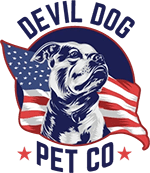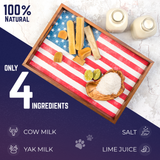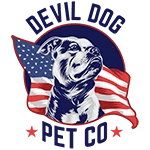Key Takeaways
- Creating a home pet-friendly environment requires intentional planning beyond just adding dog accessories.
- Securing your living space with precision is essential for your dog's safety and comfort.
- The foundation you build at home directly impacts your dog's behavior and well-being.
- Effective dog-proofing combines safety, comfort, and style in your home setup.
Table of Contents
- What Does a Truly Pet-Friendly Home Mean?
- Foundations of Dog Safety: See Your Home Through Dexter's Eyes
- Design Command: Building Your Pet's Zones for Rest, Play, and Training
- Materials That Stand the Test of Dog (and Time)
- Room-by-Room Dog-Proofing Blueprint
- Cleaning and Odor Control: Maintain Your Tactical Standard
- Dog-Safe Yards and Outdoor Zones
- Tech and Tools: Winning Edge Products
- Dog-Proofing for Every Home Type
Home Pet-Friendly – The Unfiltered Marine's Guide to a Safe, Comfortable, and Stylish Home for Dogs
Building a truly home pet-friendly environment isn't about buying the cutest dog bed or slapping up a few baby gates. It's about taking command of your space with the same precision you'd use to secure a perimeter, because your dog's safety, comfort, and behavioral success depend entirely on the foundation you create.
Real pet-friendly design eliminates hazards before they become vet bills, creates structure that prevents destructive behaviors, and uses materials that can withstand years of paws, claws, and the occasional indoor zoomies session. This isn't about sacrificing style, it's about building smarter. For more insight on how to make your new dog feel comfortable and secure, check out how to make your new dog feel at home.
Every choice you make, from flooring to furniture placement, either sets your dog up for success or leaves gaps that lead to problems. Let's lock down your home with the same thoroughness that kept Marines safe in hostile territory. If you're managing multiple dogs, you might also find these essential tips for managing multiple dogs at home helpful.
What Does a Truly Pet-Friendly Home Mean?
Foundations of Dog Safety: See Your Home Through Dexter's Eyes

Get on all fours and crawl through every room, seriously. What looks safe from human height becomes a minefield at dog level. Electrical cords become chew toys, small objects under furniture become choking hazards, and that gap behind the couch becomes a potential trap for curious snouts.
The top household dangers for dogs cluster around choking (anything under 1.5 inches diameter), chemical ingestion (cleaning products, medications, certain foods), electrical hazards (exposed cords, low outlets), and physical trauma from sharp edges or unstable objects. Most of these threats hide in plain sight until you shift perspective. For a seasonal approach to safety, see these puppy proofing your home for fall essential tips for new dog owners.
Start your safety sweep in the kitchen, the highest-risk zone. Secure cabinets containing chemicals with childproof magnetic locks (install in under 10 minutes), move trash cans inside cabinets or use locking lids, and create physical barriers around the stove and dishwasher during operation. Check that all small appliances are unplugged and cords are wrapped when not in use.
Critical Measurements for Safety
- Choking threshold: Remove objects smaller than 1.5" diameter from floor level
- Cord management: Secure or elevate any cord longer than 6 inches
- Gate clearance: Minimum 4-inch ground clearance to prevent paw entrapment
- Window safety: Install stops preventing openings wider than 4 inches
Design Command: Building Your Pet's Zones for Rest, Play, and Training
Dogs thrive on structure, and your home pet-friendly layout should reflect clear territorial boundaries. Defined zones reduce anxiety, prevent resource guarding, and give you control points for training and behavior management.
Creating a Calm Den
Size your dog's primary resting area by measuring from nose to tail base, then add 6 inches in each direction. Position this den away from high-traffic doorways (minimum 3-foot buffer) but within sight of family activity. Choose beds with removable, machine-washable covers in darker colors that hide fur and dirt between weekly cleanings.
Play and Training Command Posts
Designate specific areas for chew sessions and training work. Keep a rotating supply of appropriate chews, elk antler for power chewers, yak chews for moderate gnawers, bully sticks for training rewards, in easily accessible storage. Swap toys and chews every 3-4 days to maintain novelty and prevent boredom destruction. For more on the benefits of these chews, read about yak chews and bully sticks.
Built-In Pet Storage and Feeding Stations
Install slide-out bins for food storage, elevated feeding stations sized to your dog's wither height (measure from ground to shoulder), and quick-grab hooks near exits for leashes and waste bags. Wall-mounted dispensers keep training treats fresh and accessible during impromptu training moments.
Outdoor Entry and Wash Station Setup
Create a transition zone with hard flooring extending at least 18 inches from the door, wall hooks for leashes and towels, plus chew-safe mats rated for wet conditions. Install pressure-mounted gates with quick-release mechanisms that deploy in under five minutes when you need containment during muddy weather.
For apartment dwellers, maximize vertical space with over-door organizers and wall-mounted storage cubbies. Even a 6-inch deep entry shelf can hold daily essentials while keeping your home pet-friendly and organized.
Materials That Stand the Test of Dog (and Time)
Your home pet-friendly foundation starts with materials engineered to survive daily canine life. After six years of testing with our dog Dexter and consulting with hundreds of Devil Dog families, these surfaces deliver both durability and style. For a deeper dive into pet-proofing strategies, see this external resource on pet-proofing your home.
Flooring Performance Analysis
Luxury vinyl plank (LVP) dominates the durability contest. Quality LVP withstands 15+ years of heavy paw traffic, resists scratches from claws, and cleans with simple mopping. Ceramic tile runs second for longevity but creates noise echo and offers zero cushioning for aging joints. Hardwood looks premium but shows every scratch within months, budget $3,000+ for refinishing every 3-4 years with active dogs.
| Flooring Type | Durability (Years) | Scratch Resistance | Cleaning Ease | Cost per Sq Ft | Best For |
|---|---|---|---|---|---|
| Luxury Vinyl Plank | 15-20 | Excellent | Mop and go | $3-8 | Heavy traffic, multi-dog homes |
| Ceramic Tile | 20+ | Excellent | Moderate (grout) | $2-15 | Mudrooms, kitchens |
| Engineered Hardwood | 10-15 | Poor | Specialized cleaners | $5-12 | Low-traffic, single small dog |
| Carpet | 5-8 | Poor | Professional needed | $2-6 | Bedrooms only (not main areas) |
Chew-Resistant Furniture and Fabrics
Crypton fabric technology repels liquids, resists odors, and survives machine washing without degrading. Quality leather (full-grain, not bonded) develops character rather than damage from normal wear, lasting 10+ years versus 2-3 for standard upholstery. Avoid velvet, chenille, and silk, these fabrics trap hair, show every paw print, and require professional cleaning after minor incidents.
For budget-conscious families, washable slipcovers over basic furniture provide protection and easy maintenance. Choose covers with reinforced seams and pre-shrunk fabric to maintain fit through weekly wash cycles.
Room-by-Room Dog-Proofing Blueprint

Transform each space into a safe zone through systematic hazard elimination and smart design choices. This room-by-room approach prevents 90% of household emergencies before they happen. For more comprehensive tips, visit essential tips for pet-proofing your home.
Kitchen Safety Protocol
Install magnetic cabinet locks on lower cabinets containing cleaning supplies, these deploy in 10 minutes and resist determined paws better than traditional childproof latches. Block trash access with a cabinet-mounted pull-out system or weighted step-can that requires 15+ pounds of pressure to open. Store chocolate, xylitol gum, grapes, and onions in upper cabinets above 48 inches, beyond even jumping reach.
Living Room Hazard Management
Mount electronics and remotes on wall shelves 48+ inches high, securing cords with zip-ties and cord covers. Replace breakable décor with metal or thick ceramic alternatives that survive accidental tail wags. Install window latches that limit opening to 4 inches maximum, enough for fresh air, insufficient for escape attempts.
Bedroom and Bathroom Boundaries
Use automatic door returns on bedrooms to maintain boundaries without constant vigilance. Store medications in locked boxes rather than countertop bottles, even child-resistant caps fail against determined chewing. Latch toilet lids with adhesive locks to prevent drinking from bowls that harbor bacteria and cleaning chemicals.
For rental properties, choose pressure-mounted gates and adhesive solutions that remove cleanly. Furniture pads, removable outlet covers, and temporary cord management systems provide safety without deposit loss.
Cleaning and Odor Control: Maintain Your Tactical Standard
Consistent cleaning protocols prevent minor issues from becoming major problems. Your home pet-friendly environment requires military-grade attention to hygiene and maintenance schedules.
Grooming Schedule Optimization
Short-coat dogs need baths every 6-8 weeks; double-coated breeds extend to 8-12 weeks to preserve natural oils. Weekly brushing reduces shedding by 60% and distributes skin oils for healthier coats. Nail trims every 3-4 weeks prevent scratching damage to floors and furniture. For a quick guide, see I can trim my dog's nails in three minutes, can you?
Vacuum and Laundry Protocols
Upright vacuums with motorized brush rolls handle embedded pet hair better than canisters, requiring 2-3 passes versus 5-6 for equivalent cleaning. Schedule deep vacuuming twice weekly for high-traffic areas, daily for homes with shedding breeds. Wash dog beds and blankets weekly in hot water (140°F minimum) to eliminate bacteria and allergens.
Enzyme cleaners break down organic compounds that attract repeat marking. Mix solutions at 1:4 ratio with water for fresh accidents, full-strength for set stains. Allow 15-minute dwell time before blotting, never rub, which spreads contamination deeper into fibers.
Stain Response Protocol
Within 5 minutes: Blot excess, apply enzyme cleaner, cover with damp cloth. Set stains: Saturate area, wait 15 minutes, extract with shop vacuum, repeat if odor persists. Success rate drops 40% after the first hour.
Dog-Safe Yards and Outdoor Zones
Secure perimeters and thoughtful landscaping create outdoor spaces where dogs exercise safely while maintaining your home pet-friendly standards throughout the entire property.
Fencing and Gate Requirements
Six-foot privacy fencing contains most jumping breeds; four feet suffices for non-athletic dogs under 40 pounds. Install spring-loaded gate latches that require two-handed operation, standard thumb latches fail against clever paws. Check fence lines monthly for loose boards, dig-out attempts, and wear points that weaken security.
| Surface Type | Drainage | Durability | Maintenance | Install Cost | Best For |
|---|---|---|---|---|---|
| Natural Grass | Good | Moderate | Weekly mowing, seasonal care | $0.50-2/sq ft | Large yards, moderate traffic |
| Artificial Turf | Excellent | High | Monthly rinse, annual deep clean | $8-15/sq ft | Heavy use areas, water restrictions |
| Gravel/Stone | Excellent | High | Quarterly leveling | $2-5/sq ft | Muddy areas, drainage solutions |
| Concrete Pavers | Good | High | Annual sealing | $10-20/sq ft | Patios, high-traffic paths |
Plant Safety and Landscaping
Remove azaleas, foxglove, oleander, and sago palms, these common landscaping plants cause severe poisoning within hours of ingestion. Replace with dog-safe alternatives: sunflowers, snapdragons, and marigolds provide color without toxicity risks. Mulch with cedar chips rather than cocoa hulls, which contain theobromine similar to chocolate.
For balconies, install mesh screens or plexiglass barriers extending 12 inches above rail height. Never leave dogs unsupervised on elevated surfaces, even confident climbers miscalculate jumps when excited or distracted.
Tech and Tools: Winning Edge Products

Smart technology enhances your home pet-friendly environment through automated monitoring, safety systems, and convenience features that support consistent routines.
Monitoring and Safety Systems
GPS collars with real-time tracking locate escaped dogs within 10-foot accuracy, crucial for the 6.2 million pets entering shelters annually. Choose models with 7+ day battery life and cellular backup when WiFi fails. Wireless fence systems work for recall-trained dogs but require monthly boundary testing to prevent signal drift.
Pet cameras with two-way audio allow remote monitoring and treat dispensing during separation periods. Models with night vision and motion alerts help identify destructive behaviors before damage escalates. Position cameras to monitor chew zones and entry points where anxiety-driven behaviors typically manifest.
Automated Feeding and Exercise
Programmable feeders maintain meal schedules when work demands interfere with routine. Choose stainless steel bowls over plastic to prevent bacteria growth and chin acne. Puzzle feeders slow consumption by 50-70%, reducing bloat risk in deep-chested breeds while providing mental stimulation.
Interactive toys with treat-dispensing mechanisms occupy dogs for 20-45 minutes per session. Rotate toys every 3-4 days to maintain novelty, bored dogs create their own entertainment through destructive chewing. Quality Devil Dog Pet Co. antler chews and yak sticks provide longer-lasting engagement than electronic alternatives while supporting dental health. For more information on antler chews, see are antlers for dogs a good idea.
Dog-Proofing for Every Home Type
Effective strategies adapt to your specific living situation while maintaining comprehensive safety standards. Each home type presents unique challenges requiring targeted solutions.
Frequently Asked Questions
What are the most common household hazards for dogs and how can I effectively eliminate them?
Common hazards include small objects that pose choking risks, accessible electrical cords, toxic cleaning products, medications, and certain foods. Eliminate these by dog-proofing low spaces, securing cords out of reach, storing chemicals and meds in locked cabinets, and removing small items from floors and furniture gaps.
How can I design distinct zones in my home for my dog's rest, play, and training needs?
Create separate areas tailored to each activity: a quiet, comfy spot with a bed for rest; a durable, open space with toys for play; and a distraction-free zone with training tools and leash access. Clear boundaries help your dog understand expectations and reduce stress.
What types of materials are best suited for a durable and pet-friendly home environment?
Opt for non-toxic, scratch- and chew-resistant materials like sealed hardwood or tile floors, stain-resistant fabrics, and heavy-duty plastics or metals for furniture. These stand up to wear and are easy to clean, supporting both safety and style.
What specific safety measures should I take in high-risk areas like the kitchen to protect my dog?
Secure trash bins with lids or place them inside cabinets, keep food and cleaning supplies out of reach, use baby gates to restrict access during cooking, and ensure appliance cords are tucked away. These steps prevent ingestion of harmful substances and reduce accident risks.






